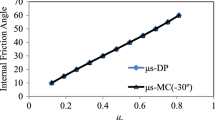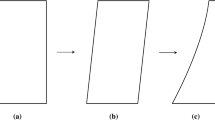Abstract
Fluidization of dry granular material is the transition from a solid state to a liquid state when sufficient energy is applied during vibration. This behavior is important because it is closely related to deformations of geotechnical structures during an earthquake. The scientific challenge lies in the understanding on how strain localization is related to the fluidization zone during the entire shearing process. Despite the importance of the mechanical behavior of granular material during fluidization, it cannot be easily characterized using traditional direct shear test. In this paper, 2D DEM model is firstly conduct, shear vibrational fluidization is defined for dry granular material, and the discrete element method has been used to simulate the direct shear test on granular material under vibrational loading during shearing. The peak, residual and vibro-residual shear strength envelopes have been obtained from the numerical simulations. Three distinct zones have been identified in the upper shear box based on the observed changes in volumetric strain before vibration. During vibration, fluidization occurs in the three zones with the characteristics that the shear stress, porosity, volumetric strain, and the coordination number drop to relatively lower values. During vibration, material becomes denser than the critical state, and strain localization has been relieved. Densification of the material at the shear zone leads to a strengthening of the material which increases the shearing resistance after vibration. Furthermore, a comparison of the 2D and 3D simulations is performed. Results reveal that the motion of particles in the out-of-plane direction in the 3D simulations lead to smoother shear stress and more consistent with the experimental result.

















Similar content being viewed by others
References
ASTM: Standard test method for direct shear test of soils under consolidated drained conditions. D3080/D3080 M. West Conshohocken, PA (2011)
Chen, W., Qiu, T.: Numerical simulations for large deformation of granular materials using smoothed particle hydrodynamics method. Int. J. Geomech. 12(2), 127–135 (2012). https://doi.org/10.1061/(asce)gm.1943-5622.0000149
Chiou, M.: Modelling of dry granular avalanches past different obstructs: numerical simulations and laboratory analyses. Ph.D. dissertation, Technical University Darmstadt (2005)
Cui, Y., Nouri, A., Chan, D., Rahmati, E.: A new approach to DEM simulation of sand production. J. Petrol. Sci. Eng. 147, 56–67 (2016)
Cui, Y., Chan, D., Nouri, A.: Discontinuum modeling of solid deformation pore-water diffusion coupling. Int. J. Geomech. (2017). https://doi.org/10.1061/(asce)gm.1943-5622.0000903
Cui, Y., Choi, C.E., Liu, L.H.D., Ng, C.W.W.: Effects of particle size of mono-disperse granular flows impacting a rigid barrier. Nat. Hazards 91, 1179–1201 (2018)
Cundall, P.A., Strack, O.D.L.: A discrete numerical model for granular assemblies. Géotechnique 29(1), 47–65 (1979)
Ding, W.T., Xu, W.J.: Study on the multiphase fluid-solid interaction in granular materials based on an LBM-DEM coupled method. Powder Technol. 335(15), 301–314 (2018)
Ding, X., Zhang, L., Zhu, H., Zhang, Q.: Effect of model scale and particle size distribution on PFC3D simulation results. Rock Mech. Rock Eng. 47, 2139–2156 (2014)
Dove, J.E., Jarrett, J.B.: Behavior of dilative sand interface in a geotribology framework. J. Geotech. Geoenviron. Eng. 12(1), 25–37 (2002)
Fan, X., Li, K., Lai, H., Xie, Y., Cao, R., Zheng, J.: Internal stress distribution and cracking around flaws and openings of rock block under uniaxial compression: a particle mechanics approach. Comput. Geotech. 102, 28–38 (2018)
Fauve, S., Douady, S., Laroche, C.: Collective behaviours of granular masses under vertical vibrations. J. Phys. Colloq. 50(C3), 187–191 (1989)
Fleischmann, J.A., Plesha, M.E., Drugan, W.J.: Quantitative comparison of two-dimensional and three-dimensional discrete-element simulations of nominally two-dimensional shear flow. Int. J. Geomech. 13(3), 205–212 (2013)
Fu, Y.: Experimental quantification and DEM simulation of micro-macro behaviors of granular materials using x-ray tomography imaging. J. Therm. Anal. Calorim. 90(3), 873–879 (2005)
Goldshtein, A., Shapiro, M., Moldavsky, L., Fichman, M.: Mechanics of collisional motion of granular materials. Part 2. Wave propagation through vibrofluidized granular layers. J. Fluid Mech. 287, 349–382 (1995)
Götzendorfer, A., Tai, C.H., Kruelle, C.A., Rehberg, I., Hsiau, S.S.: Fluidization of a vertically vibrated two-dimensional hard sphere packing: a granular meltdown. Phys. Rev. E 74(1), 011304 (2006)
Gu, X.Q., Yang, J.A.: Discrete element analysis of elastic properties of granular materials. Granul. Matter 15(2), 139–147 (2013)
Huan, C.: NMR experiments on vibrofluidized and gas fluidized granular systems. Ph.D. thesis, University of Massachusetts Amherst, USA (2008)
Huang, D., Wang, G.: Energy-compatible and spectrum-compatible (ECSC) ground motion simulation using wavelet packets. Earthq. Eng. Struct. Dyn. 46(11), 1855–1873 (2017)
Itasca Consulting Group: Inc. PFC3D, version 4.0. Minneapolis, USA (2008)
Jaeger, H.M., Nagel, S.R., Behringer, R.P.: Granular solids, liquids, and gases. Rev. Mod. Phys. 68, 1259 (1996)
Jenkins, J.T., Strack, O.D.L.: Mean-field inelastic behavior of random arrays of identical spheres. Mech. Mater. 16(1–2), 25–33 (1993)
Kang, C., Chan, D.: Numerical simulation of 2D granular flow entrainment using DEM. Granul. Matter 20, 13 (2018). https://doi.org/10.1007/s10035-017-0782-x
Law, R.H., Choi, C.E., Ng, C.W.W.: Discrete element investigation of the influence of debris flow bafes on rigid barrier impact. Can. Geotech. J. 53(2), 179–185 (2015)
Liu, Z., Koyi, H.A.: Kinematics and internal deformation of granular slopes: insights from discrete element modeling. Landslides 10(2), 139–160 (2013)
Otsubo, M., O’Sullivan, C., Shire, T.: Empirical assessment of the critical time increment in explicit particulate discrete element method simulations. Comput. Geotech. 86, 67–79 (2017)
Payne, F.C., Quinnan, J.A., Potter, S.T.: Remediation Hydraulics. CRC Press, Boca Raton (2008)
Potyondy, D.O., Cundall, P.A.: A bonded-particle model for rock. Int. J. Rock Mech. Min. Sci. 41(8), 1329–1364 (2004)
Radjai, F., Evesque, P., Bideau, D., Roux, S.: Stick-slip dynamics of a one-dimensional array of particles. Phys. Rev. E 52(5), 5555–5564 (1995)
Richards, R.J., Elms, D.G., Budhu, M.: Dynamic fluidization of soils. J. Geotech. Eng. (1990). https://doi.org/10.1061/(ASCE)0733-9410(1990)116:5(740)
Ristow, G.H., Strassburger, G., Rehberg, I.: Phase diagram and scaling of granular materials under horizontal vibrations. Phy. Rev. Lett. 79(5), 833–836 (1997)
Salot, C., Gotteland, P., Villard, P.: Influence of relative density on granular materials behavior: DEM simulations of triaxial tests. Granul. Matter 11(4), 221–236 (2009)
Schofield, A.N., Wroth, C.P.: Critical State Soil Mechanics. McGraw-Hill, New York City (1968). ISBN 978-0641940484
Shi, X.S., Herle, I.: Numerical simulation of lumpy soils using a hypoplastic model. Acta Geotech. 12(2), 349–363 (2017)
Shi, X.S., Herle, I., Muir Wood, D.: A consolidation model for lumpy composite soils in open-pit mining. Géotechnique 68(3), 189–204 (2018)
Sjögren, B.A., Berglund, L.A.: Failure mechanisms in polypropylene with glass beads. Polym. Composite. 18(1), 1–8 (1997)
Tang, Y., Chan, D.H., Zhu, D.Z.: A coupled discrete element model for the simulation of soil and water flow through an orifice. Int. J. Numer. Anal. Met. (2017). https://doi.org/10.1002/nag.2677
Tang, Y., Chan, D.H., Zhu, D.Z.: Numerical Investigation of sand-bed erosion by an upward water jet. J. Eng. Mech. 143(9), 04017104 (2017)
Teufelsbauer, H., Wang, Y., Chiou, M.C., Wu, W.: Flow–obstacle interaction in rapid granular avalanches: DEM simulation and comparison with experiment. Granul. Matter 11(4), 209–220 (2009)
Thorton, C.: Coefficient of restitution for collinear collisions of elastic-perfectly plastic spheres. J. Appl. Mech. 64(2), 383–386 (1997)
Thornton, C.: Numerical simulations of deviatoric shear deformation of granular media. Géotechnique 50(1), 43–53 (2000)
Taslagyan, K.A., Chan, D.H., Morgenstern, N.R.: A direct shear apparatus with vibrational loading. Geotech. Test. J. 38(1), 1–8 (2015)
Taslagyan, K.A., Chan, D.H., Morgenstern, N.R.: Effect of vibration on the critical state of dry granular soils. Granul. Matter 17(6), 687–702 (2015)
Taslagyan, K.A., Chan, D.H., Morgenstern, N.R.: Vibrational fluidization of granular media. Int. J. Geomech. (2016). https://doi.org/10.1061/(asce)gm.1943-5622.0000568
Wang, J., Gutierrez, M.: Discrete element simulations of direct shear specimen scale effects. Géotechnique 60(5), 395–409 (2010)
Wong, R.H.C., Lin, P., Tang, C.A.: Experimental and numerical study on splitting failure of brittle solids containing single pore under uniaxial compression. Mech. Mater. 38, 142–159 (2006)
Xu, W.J., Hu, L.M., Gao, W.: Random generation of the meso-structure of a soil–rock mixture and its application in the study of the mechanical behaviors in a landslide dam. Int. J. Rock. Mech. Min. 86, 166–178 (2016)
Zhang, Z., Zhang, X., Qiu, H., Daddow, M.: Dynamic characteristics of track-ballast-silty clay with irregular vibration levels generated by high-speed train based on DEM. Constr. Build. Mater. 125, 564–573 (2016)
Zhang, Z., Zhang, X., Tang, Y., Cui, Y.: Discrete element analysis of a cross-river tunnel under random vibration levels induced by trains operating during the flood season. J. Zhejiang Univ. SC. A 19(5), 346–366 (2018)
Zhao, T.: Investigation of Landslide-Induced Debris Flows by the DEM and CFD. Ph.D. thesis. University of Oxford, UK (2014)
Acknowledgements
The project was financially supported by an NSERC Postgraduate Scholarship and Alberta Innovates Graduate Student Scholarship. The authors are grateful for financial support from the Opening Fund of State Key Laboratory of Hydraulics and Mountain River Engineering (SKHL1609) and Hong Kong Research Grants Council (T22-603/15N). The project was also supported by the Natural Sciences and Engineering Research Council of Canada (RGPIN 355485) and the key international collaborative project of the Natural Science Foundation of China (No. 41520104002) and the Fundamental Research Funds for the Central Universities (2017-YB-014; WUT: 2017IVB079).
Author information
Authors and Affiliations
Corresponding author
Ethics declarations
Conflict of interest
The authors declare that they have no conflict of interest.
Appendix: Servomechanism for computing and controlling the wall-based stress state
Appendix: Servomechanism for computing and controlling the wall-based stress state
Throughout the loading process, the top normal stress is kept constant by adjusting the top loading wall velocity using a numerical servomechanism. The servomechanism implements the following algorithm [20]. The equation for wall velocity \( \dot{u}^{w} \) is calculated in Eq. A1:
where the superscript \( w \) represents wall, \( \sigma^{\text{measured}} \) is the contact pressure of the wall which is measured during shearing, \( \sigma^{\text{required}} \) is the required contact pressure that we set, \( G \) is a calculated parameter that is estimated from Eqs. A2–A6.
The maximum increment in wall force arising from the wall movement in one time step is calculated from Eq. A2:
where \( N_{c} \) is the number of contacts on the wall, \( k_{n}^{c} \) is the average combined normal stiffness of the two contacting entities (ball-to-wall), \( k_{n}^{b} \) and \( k_{n}^{w} \) are the normal stiffness of the ball and the wall, respectively, the superscript symbol \( b \) represents balls, \( \Delta t \) is the DEM simulation time step. Therefore, the change in the average wall stress is calculated from Eq. A3:
where A is the wall area. For stability, the absolute value of the change in wall stress must be less than the absolute value of the difference between the measured and required stresses. In practice, a relaxation factor \( \alpha \) is used such that the stability requirement becomes that:
Substituting Eqs. A1 and A3 into Eq. A4 yields:
The “gain” parameter \( G \) is determined using Eq. A6:
Here, α is the relaxation factor which is equal to 0.5, A is the area of the top plane, in the 2D numerical model, A is the area of the top loading plane, which is equal to the length of the top loading plane multiplies by the width of the box. In current study, A = 60 mm × 60 mm.
Rights and permissions
About this article
Cite this article
Zhang, Z., Cui, Y., Chan, D.H. et al. DEM simulation of shear vibrational fluidization of granular material. Granular Matter 20, 71 (2018). https://doi.org/10.1007/s10035-018-0844-8
Received:
Published:
DOI: https://doi.org/10.1007/s10035-018-0844-8




